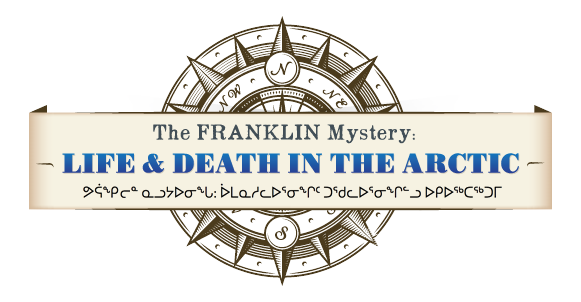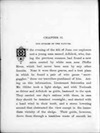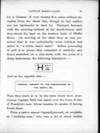Adlekok and Ogzenekjenwoek tell Schwatka of cairn, relics, boat, dead bodies; Admiral Richards' response to Cannibalism (1882)
ON the evening of the 4th of June our explorers met a young man named Adlekok, who, during the previous summer, had found a new cairn erected by white men near Pfeffer River, which had never been seen by any other Innuits. Near it were three graves, and a tent place in which he found a pair of wire gauze "snow- goggles:" these our travellers purchased of him. Acting on this information, Lieutenant Schwatka and Mr. Gilder took a light sledge, and with Toolooah as driver and Adlekok as guide, hastened to the spot. They carried one day's rations with them, in case they should be detained overnight; and started with a head wind in their teeth, and a storm lowering around that obstructed the view except in the immediate vicinity of the sledge. Their guide, however, drove them through a trackless waste of smooth ice for a distance of over twenty-five miles without deviation from the direct line, though he had neither sun nor landmarks to steer by. Forward, forward, with the unerring instinct of the sleuth-hound, until they struck the land on the western bank of Pfeffer River. On arriving at the cairn they at once perceived that it was undoubtedly what Adlekok had called it, "a white man's cairn." Before proceeding to pull it to pieces, they examined it carefully, and found scratched on a clay-stone, with the point of a sharp instrument, the following inscription :—
H MAY XII 1869
And on the opposite side :-
ETERNAL HONOUR TO THE DISCOVERERS OF
THE NORTH WE...
Then they knew it to be the cairn which their countryman Captain Hall had raised over the bones of two of Franklin's men, whose remains he speaks of having found there.
From a native named Ogzenekjenwoek, an aruketko, or "medicine-man," who was a lad of about twelve years old when he first visited "the boat place," and from his mother, some interesting, if painful, particulars were obtained.
It appears that they never met with any of Franklin's men alive, but saw four skeletons on the mainland, and two on an adjacent island -- an island on the southern coast in long. 95° W. At neither place were any graves. They found at the boat place a tin box, the contents of which were printed books, each about two feet long and a foot wide, and among them what was probably the needle of a compass or other magnetic instrument, for they said that when it touched iron it stuck fast. Outside the boat were skulls; the exact number they could not remember, but more than four. They also found a quantity of bones from legs and arms which appeared to have been sawed off. Inside the boat was a box filled with bones, the box being about the same size as the one with books in it; and from their appearance the Innuits concluded "that the white men had been eating each other." What little flesh still adhered to the bones was very fresh; one body was fully covered. The hair was light, and the body looked like that of a tall man. Ogzenekjenwoek saw a number of wire "snow-goggles," and alongside the body with flesh on it was a pair of gold spectacles. He discovered more than one or two pairs of such spectacles, but had forgotten how many. When asked how long the bodies appeared to have been dead, he replied that they had probably died during the previous winter.
In the boat he saw canvas and four sticks (that is, either a tent or a sail), and several open-faced watches, some of which were gold, but most silver. These were given to the children to play with, but had been broken up and lost. One body, that with flesh on, wore a gold chain fastened to gold ear-rings, and a gold hunting-case watch attached to the chain, and hanging down about the waist. The Eskimo added that when he pulled the chain, it pulled the head up by the ears. This body had also a gold ring on the ring-finger of the right hand. In reference to this statement, the American chronicler of Schwatka's expedition remarks that the chain may in some way have become attached to the ears, or, ridiculous as the story sounds, there may have been some eccentric person in the party who wore his watch in that way; and if such should prove to be the case, this would certainly identify him beyond doubt. But we believe no such identification has taken place.
The Eskimo's reason for thinking that the survivors of Franklin's expedition had resorted to cannibalism was, because the bones had been cut with a knife or a saw. A big saw and a small saw were found in the boat; also a large red tin can of smoking tobacco and some pipes. There was no cairn at the place. The bones, he said, were now covered up with sand and sea-weed, as they were lying just at high-water mark.*
It seems not improbable that the skeletons found at this place were the remains of some of the party who were seen by Ahlangyah and her friends in Washington Bay. The gold watches are a testimony that there were officers in the party. The five men who had a tent on shore were perhaps officers. We may surmise that the books found in the tin box were the more important records of the expedition, and in charge of the chief surviving officers. It is unlikely that men reduced to dire extremity, and compelled to drag everything by land, would burden themselves with miscellaneous reading matter. Judging from the relics obtained, the boat must have been a heavy one and copper-bottomed; for most of the kettles found in use among the Netchelliks were made of sheet copper, which came, they said, from this and the other boats in Erebus Bay. But as it was an absolute necessity, the unfortunate castaways could not abandon it.
* Admiral Richards, in a letter to the Times (October 20, 1880), speaks of the assertion that Franklin's men in their last extremity resorted to cannibalism as without "one tittle of foundation;" and it will be seen that the American writers give absolutely no valid reason in support of it. The Eskimo based his conviction on the fact that some of the limbs had been removed as if by saw. Supposing this to be the case, the natives were probably the operators. "The intercourse between the natives and such of Franklin's men as they met with is surrounded with circumstances of grave suspicion as gathered from themselves, and this suspicion derives strength from various circumstances related on Schwatka's journey. Certainly he and his party appear to have had little confidence in the tribes they met with in the neighbourhood of the Great Fish River; and if there was any foul play towards the retreating parties of Franklin's ships, it would manifestly be to the interest of the natives to divert suspicion from themselves by any means in their power." Admiral Richards goes on to point out that the crews of the Erebus and the Terror, when they abandoned their ships, were doubtless for the most part suffering from exhaustion and scurvy; death had been staring them in the face for months. They started to undertake a journey which men in strong health and under the most "favourable circumstances might well have shrunk from as hopeless. It was, in fact, a forlorn hope. The greater part of them probably died from exhaustion and disease long before they had got one hundred miles from their ships, and found their graves beneath the ice when it melted in summer, or on the beach of King William Land. It may be assumed that no more than half-a dozen out of the whole crews ever reached the entrance of the Great Fish River. We need not call in starvation to our aid. I fully believe that by far the greater portion perished long before their provisions were consumed. The only thing that would have restored men to convalescence in their condition would have been nursing and the comforts of hospital treatment, not a resort to human flesh. The thing appears so monstrous to me that I am at a loss to conceive how it can have been suggested. Death would have had no terror for men in their position. It may perhaps be thought that I am dealing in probabilities; but I will gladly be judged by any officer who has ever served in the Arctic regions as to the soundness of my views."




